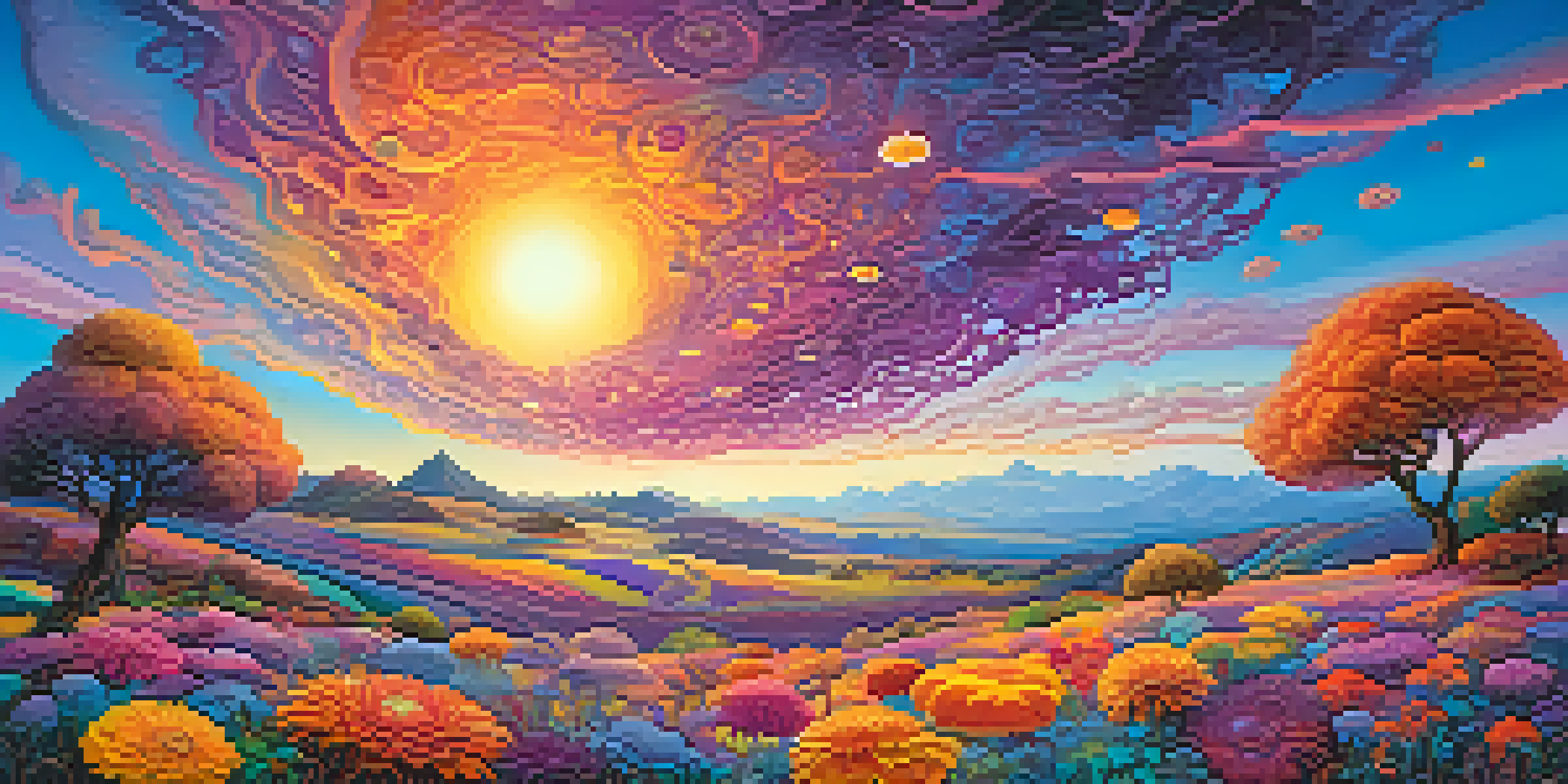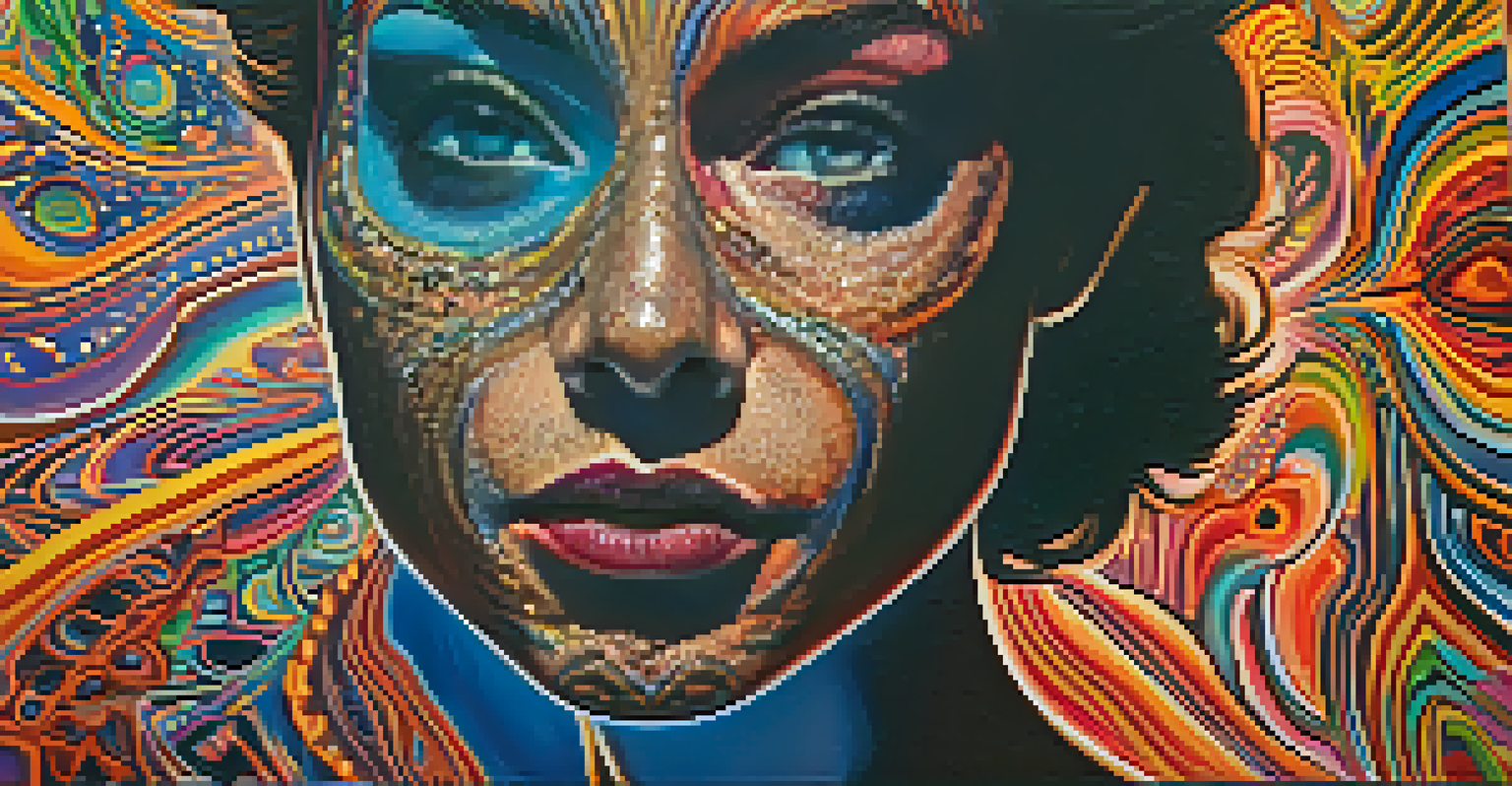Entheogens as a Medium: Artists Who Use Psychedelic Substances

What Are Entheogens and Their Artistic Appeal?
Entheogens are substances, often derived from plants, that have been used in spiritual and creative practices for centuries. They can alter perceptions, emotions, and thoughts, providing a unique lens through which artists can explore their inner worlds. This deep dive into consciousness often leads to innovative ideas and artistic breakthroughs.
Psychedelics can help us see our individual lives and experiences as part of a greater whole.
Artists are drawn to entheogens for their ability to dissolve boundaries and enhance creativity. Imagine stepping into a vibrant dream where colors are more vivid, sounds are more resonant, and emotions are profoundly intensified. This altered state can inspire artists to create works that reflect their expanded perceptions and insights.
Throughout history, various cultures have recognized the power of entheogens. From the ancient Aztecs using peyote to the modern-day artists experimenting with substances like LSD, these experiences have shaped artistic movements and individual works. This connection between psychedelics and creativity underscores the deep intertwining of art and altered states of consciousness.
Famous Artists Who Embraced Psychedelic Experiences
Many renowned artists have openly embraced entheogens to fuel their creative processes. For instance, the legendary painter Salvador Dalí often experimented with hallucinogens, which influenced his surrealist style. His work is a testament to how altered states can unlock unique perspectives and imaginative concepts.

Another notable figure is musician Jimi Hendrix, who famously used psychedelics to enhance his musical compositions. His songs, characterized by intricate soundscapes and innovative guitar techniques, reflect the expansive nature of his psychedelic experiences. This highlights how entheogens can transcend traditional boundaries and push artistic expression to new heights.
Entheogens Boost Artistic Creativity
Entheogens provide artists with altered states of consciousness that enhance creativity and inspire innovative ideas.
Additionally, contemporary artists like Alex Grey incorporate their psychedelic experiences into their art, creating intricate and spiritually themed works. Grey’s paintings often depict the interconnectedness of life and consciousness, showcasing how entheogens can lead to profound insights that resonate deeply with viewers.
The Creative Process: Entheogens as a Tool
For many artists, the use of entheogens is not just about the experience itself but how it enhances their creative process. These substances can help break down mental barriers, allowing ideas to flow more freely. It’s like tapping into a wellspring of creativity that may have been previously inaccessible.
The creative process is a process of surrender, not control.
During these experiences, artists often report heightened senses, vivid imagery, and a deep connection to their work. This can lead to unexpected artistic choices and innovative techniques, creating a unique fusion of inspiration and expression. The spontaneous nature of these insights can be exhilarating, often transforming the final piece in unexpected ways.
Moreover, the communal aspect of using entheogens can foster collaboration among artists. Sharing these experiences can lead to collective brainstorming sessions, where ideas evolve and multiply in a supportive environment. This synergy often results in groundbreaking art that reflects the shared journey of creativity.
The Risks and Responsibilities of Using Entheogens
While entheogens can offer profound insights, they also come with risks that artists must navigate carefully. Not every experience leads to positive outcomes; some can result in anxiety or disorientation. Understanding one's mental state and environment is crucial before embarking on such journeys.
Furthermore, the legal status of many entheogens poses challenges for artists. In some regions, these substances are illegal, which can lead to legal repercussions. Artists must weigh the potential benefits against the risks, ensuring they approach their creative explorations responsibly.
Famous Artists Use Psychedelics
Many renowned artists, like Salvador Dalí and Jimi Hendrix, have embraced entheogens to unlock unique perspectives in their work.
It's also essential to recognize that not all artists need to use entheogens to create impactful work. Many find inspiration through other means, such as nature, meditation, or personal experiences. The key lies in understanding one's creative process and finding what resonates best without compromising well-being.
Entheogens in Modern Art Movements
In recent years, there has been a resurgence of interest in the relationship between entheogens and modern art movements. Artists today are exploring these substances not just for personal insight but as a commentary on society and culture. This exploration often leads to art that challenges conventional perspectives.
Movements such as psychedelic art have gained popularity, with artists drawing inspiration from their own experiences with entheogens. This genre often features vibrant colors, surreal imagery, and themes of interconnectedness, reflecting the unique insights gained during these experiences. It’s a bold and expressive way to translate internal revelations into visual form.
Additionally, contemporary art exhibitions often highlight the intersection of psychedelics and creativity. These events provide a platform for artists to showcase work inspired by altered states, sparking conversations about the role of entheogens in the creative process. This openness helps to destigmatize the use of these substances while celebrating their potential to inspire and transform.
The Science Behind Psychedelics and Creativity
Research into the effects of psychedelics on the brain is ongoing, but some findings suggest these substances can enhance creative thinking. Studies have shown that psychedelics may increase neural connectivity, allowing different areas of the brain to communicate more effectively. This heightened connectivity can lead to novel ideas and creative solutions.
Moreover, the experiences induced by entheogens often encourage divergent thinking, where multiple solutions to a problem are explored. This contrasts with convergent thinking, which focuses on finding a single, correct answer. By fostering an environment of exploration and openness, psychedelics can help artists approach their work from fresh angles.
Risks of Using Entheogens
While entheogens can inspire, artists must navigate the potential risks and legal challenges associated with their use.
As the scientific community continues to study the relationship between psychedelics and creativity, artists may find new ways to harness these insights for their work. This fusion of science and art can lead to a deeper understanding of the creative process, ultimately enriching the artistic landscape.
Future Perspectives: The Role of Entheogens in Art
Looking ahead, the role of entheogens in art is likely to evolve as societal perceptions shift. With increasing interest in mental health and wellness, some artists are advocating for the responsible use of psychedelics as tools for healing and creativity. This movement could pave the way for more open discussions about the benefits and risks involved.
Furthermore, as more artists share their experiences and insights, we may see a broader acceptance of entheogens within the creative community. This acceptance could lead to innovative collaborations and projects that push the boundaries of traditional art forms. The dialogue surrounding psychedelics and creativity will undoubtedly continue to grow.

Ultimately, the intersection of entheogens and art invites us to explore our inner landscapes and express them in diverse ways. As we navigate this evolving terrain, it’s essential to approach these experiences with curiosity and respect, embracing the potential for growth and transformation in both art and life.